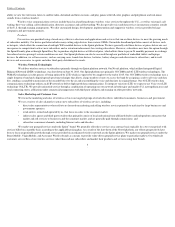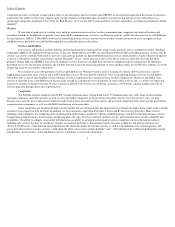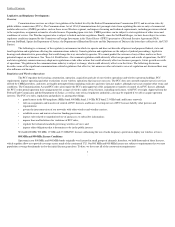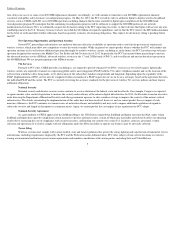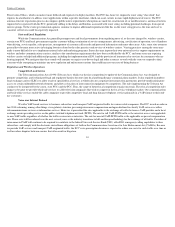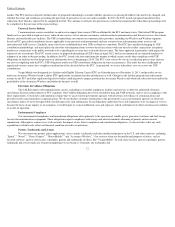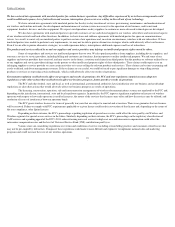Sprint - Nextel 2013 Annual Report Download - page 16
Download and view the complete annual report
Please find page 16 of the 2013 Sprint - Nextel annual report below. You can navigate through the pages in the report by either clicking on the pages listed below, or by using the keyword search tool below to find specific information within the annual report.
Table of Contents
Our ability to retain subscribers may be negatively affected by industry trends related to subscriber contracts. For example, we and some of our
competitors no longer require consumers to enter into annual service contracts for postpaid service. In addition, we have recently seen aggressive marketing
efforts initiated by our competitors, including offering substantive additional incentives for subscribers to switch carriers. These types of changes could
negatively affect our ability to retain subscribers and could lead to an increase in our churn rates if we are not successful in providing an attractive product and
service mix.
Moreover, service providers frequently offer wireless equipment, such as devices, below acquisition cost as a method to retain and attract
subscribers that enter into wireless service agreements for periods usually extending 12 to 24 months. Equipment cost in excess of the revenue generated from
equipment sales is referred to in the industry as equipment net subsidy and is generally recognized as an expense when title of the device passes to the dealer or
end
-
user subscriber. The cost of multi
-
functional devices, such as smartphones, including the iPhone®
,
has increased significantly in recent years as a result of
enhanced capabilities and functionality. At the same time, wireless service providers continue to compete on the basis of price, including the price of devices
offered to subscribers, which has resulted in increased equipment net subsidy. In 2011, we entered into a purchase commitment with Apple, Inc. that increases
the average equipment net subsidy for postpaid devices resulting in a reduction to consolidated results from operations and reduced cash flow from operations
associated with initiation of service for these devices until such time that retail service revenues associated with subscribers acquiring these devices exceeds
such costs.
We expect to incur expenses to attract new subscribers, improve subscriber retention and reduce churn, but there can be no assurance that our
efforts will result in new subscribers or a lower rate of subscriber churn. Subscriber losses and a high rate of churn could adversely affect our business, financial
condition and results of operations because they result in lost revenues and cash flow. Although attracting new subscribers and retention of existing
subscribers are important to the financial viability of our business, there is an added focus on retention because the cost of adding a new subscriber is higher
than the cost associated with retention of an existing subscriber.
Competition and technological changes in the market for wireless services could negatively affect our average revenue per subscriber, subscriber churn,
operating costs and our ability to attract new subscribers, resulting in adverse effects on our revenues, cash flows, growth and profitability.
We compete with a number of other wireless service providers in each of the markets in which we provide wireless services, and we expect
competition may increase if additional spectrum is made available for commercial wireless services and as new technologies are developed and launched. As
smartphone penetration increases, we continue to expect an increased usage of data on our network. Competition in pricing and service and product offerings
may also adversely impact subscriber retention and our ability to attract new subscribers, with adverse effects on our results of operations. A decline in the
average revenue per subscriber coupled with a decline in the number of subscribers would negatively impact our revenues, cash flows and profitability, which,
in turn, could adversely impact our ability to meet our financial obligations.
The wireless communications industry is experiencing significant technological change, including improvements in the capacity and quality of digital
technology and the deployment of unlicensed spectrum devices. These developments cause uncertainty about future subscriber demand for our wireless
services and the prices that we will be able to charge for these services. As services, technology and devices evolve, we also expect continued pressure on
voice, text and other service revenue. Spending by our competitors on new wireless services and network improvements could enable our competitors to obtain
a competitive advantage with new technologies or enhancements that we do not offer. Rapid changes in technology may lead to the development of wireless
communications technologies, products or alternative services that are superior to our technologies, products or
14
•
actual or perceived quality and coverage of our networks;
•
public perception about our brands;
•
our ability to anticipate and develop new or enhanced technologies, products and services that are attractive to existing or potential
subscribers;
•
our ability to access additional spectrum; and
•
our ability to maintain our current mobile virtual network operator (MVNO) relationships and to enter into new arrangements with MVNOs.


